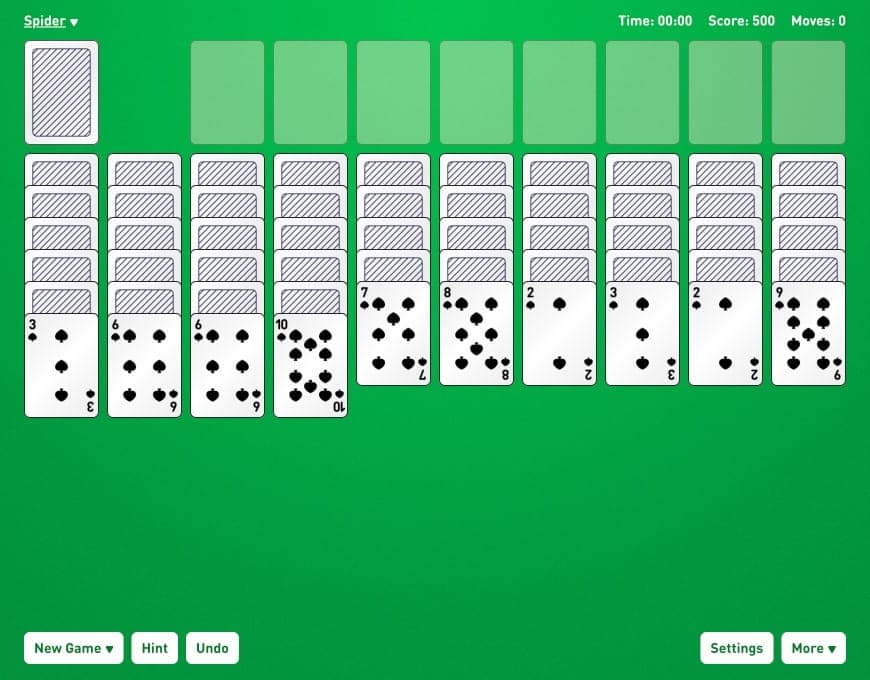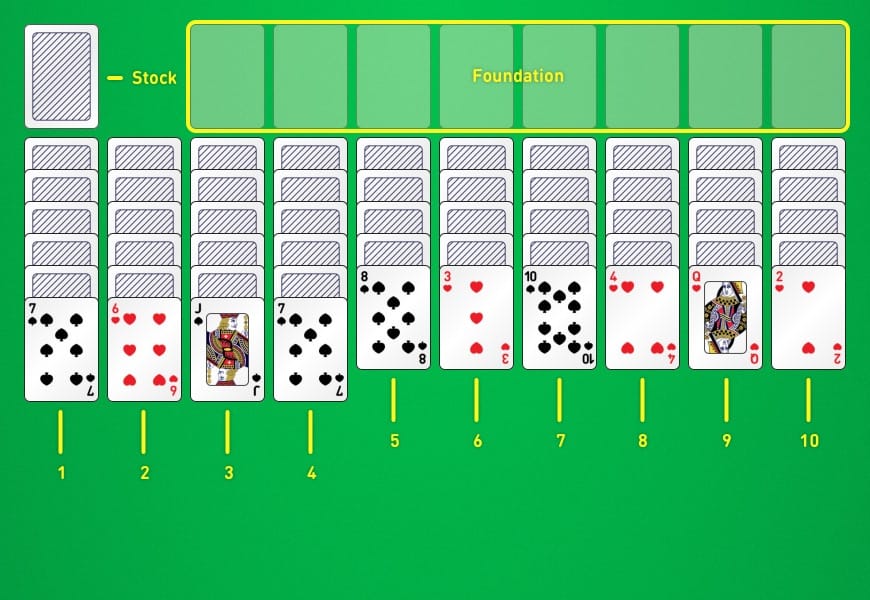Play Spider Solitaire Online for Free (No Signup Required)
Afraid of spiders? No need to be afraid of this oldie but goodie. It can be a brain twister, all right. But you can do it.

This popular game got its name back in 1949 when it was created. Like the spider, it has eight "legs" - in the game's case, meaning the foundation piles, where all the cards end up if you win the game.
It has got ten columns in the plateau, so there's a lot to keep track of. We recommend starting out with the one-suit version. This Itsy Bitsy Spider will make you feel invincible. Then, go on to the Spider Solitaire 2 Suits. You might find that spider makes quite a bit of resistance. And if you feel like a true Spiderman from there, go on and tackle the Spider Solitaire 4 Suits. That's a real brain-buster!
You can always choose a winning deal, but remember there are no guarantees. A winning deal is a deal that can be won, a deal that is solvable. It might be called a winning deal, but my goodness, you have to be on your toes all the time to win the deal. The only thing guaranteed is that you will have a good time.
Have fun, and stay sharp!
Holger
3409
4.794367849809328 ratings
I love to start with the 1 suit version of this free Spider Solitaire game. That really boosts my confidence, and soon, I'm ready to take on the 2 suit version.
Peter Brooks
For this game of Patience, you really need patience. It is ever so hard, but that only tickles my brain.
Sarah Preston
How to play Spider Solitaire 1 Suit
This summary is for all of you who have played the game before but need a refresher on how to play. If you're a beginner, check out my guide on how to play Spider Solitaire complete with illustrations and a video tutorial.

Unlike other solitaire games, this one is played with two decks of playing cards. The goal of the game is to remove all cards from the tableau and on to the foundation piles.
The layout of the game can be divided into three main areas:
- The tableau: This is where you'll make most of your moves.
- The stock: This is the pile of cards face down from which you draw.
- The foundation: This is where you want all your cards to end up ordered by suit and rank. It is the spider's eight legs.

To get cards from the tableau onto the foundation, you have to rank them from king to ace on the tableau. Cards can always be moved to a higher-ranking card. For example, if you have seven spades, you can put it on eight spades or eight of any other color. As a result, different suits of cards can be stacked on top of one other.
The game's goal is to make runs of cards from king to ace in the same suit. Once you have a complete sequence of cards, they will be moved to the foundation. Only if the sequence of cards is of the same suit will this happen.
If all of the cards in a run have the same suit, you can move them all simultaneously. For example, if you have the eight of spades through the six of spades, you can click and drag them all to a nine of hearts. You can't move them together if you have the eight of spades, the seven and six of clubs. After that, you'll have to move them one at a time.
You can move any card or partial run to an empty tableau spot if you have one.
When you have no more moves to make on the tableau, you can click on the stock in the top left corner. That will move ten cards from the stock down to the tableau, placing one card on each tableau. We don't recommend doing this before you're completely sure there are no moves left.
Good luck playing!
Must warn you all: These games are addictive. So fun and cozy they make time fly.
Hannah Smith
No fuss, no muss, no bells and whistles - just simple solitaire games. I love it!
Brittany Hudson
Frequently Asked Questions (FAQ)
If your questions aren't answered by our FAQ below, feel free to reach out at contact@online-solitaire.com, and we'll do our best to help you.
What is Spider Solitaire?
It's a Patience game, much like Solitaire or FreeCell. It was first popularized by Microsoft and was released with their Windows 95 operating system, where most people today know it. It is considered one of the more challenging types of Patience games, and a good deal of strategy and luck is needed to win the game.
How do you set up the game?
Two full decks are used in this game. So, there are a total of 104 cards. When a new game is started, 54 cards are divided into ten tableaus. Each of the first four tableaus has five cards, and each of the following tableaus has five cards. Each tableau's top card is turned face up, while the others stay face down. The remaining 50 cards are placed in the stock's upper left corner of the screen.
Do you have an app?
You bet we do! Our app is free to download and is available for Windows™, Mac™, Linux™, Android, or iOS. We also have an app for Amazon Kindle and an extension for Google Chrome.